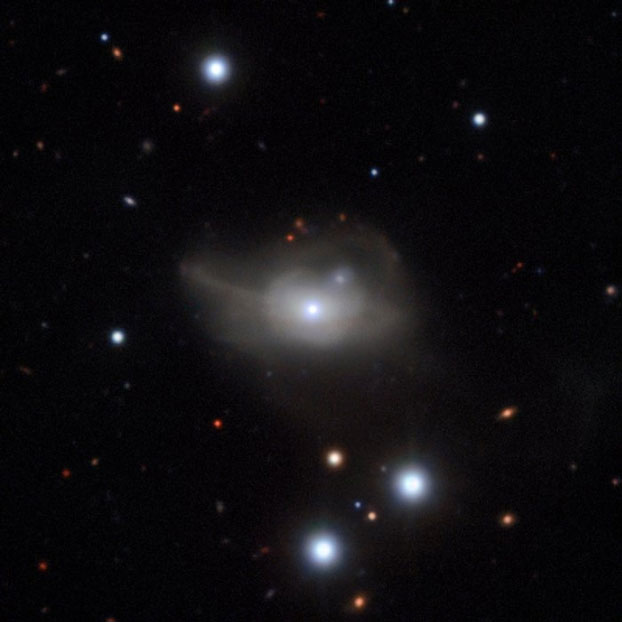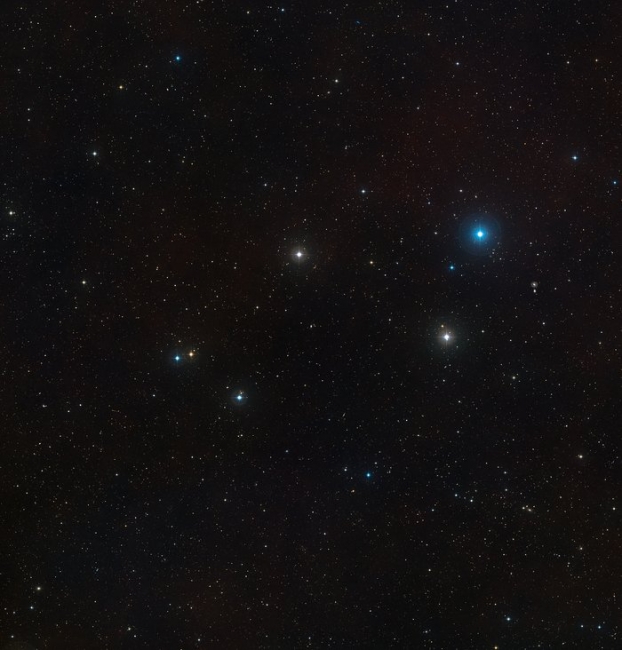Many galaxies possess an extremely bright core due to the presence of a supermassive black hole. Such cores transform these “active galaxies” into some of the brightest objects in the Universe. Their extreme luminosity is due to the fall of hot material into the black hole, a process called accretion. This intense radiation varies from active galaxy to active galaxy, so that the characteristics of the light emitted have led to the classification of these galaxies into various types+-1.

Observation has shown that some of these galaxies can undergo spectacular changes over periods of hardly a decade – a blink on the scale of astronomical time. The active galaxy Markarian 1018, the target of this new study, has undergone no less than two changes, the second one restoring its original appearance during a period of five
years. For the first time, this entire cycle, which has also been observed in a few other galaxies, has been studied for the first time in detail.
The discovery of the variable naturre of Markarian 1018 is due to the CARS project, which links ESO with various other organizations and whose objective is to accumulate information on 40 neighbouring having and active core. Routine observations of Markarian 1018 carried out with the help of the MUSE (Multi-Unit Spectroscopic Explorer) instrument on ESO’s VLT revelaed this galaxie’s strange brightness changes.
The team of scientists exploited this event : their primary priority was to identify the process responsible for the violent brightness changes of Markarian 1018. Various astrophysical processes could have been responsible for this event, but the team was able to eliminate the absorption of an ordinary star by the black hole2 and questioned the posibility of screening by the surrounding gas3. The initial observations have not led to the identification of the process which is at the heart of the darkening of Markarian 1018.

The scientists were able to obtain complementary data, through the the allocation of observing time on ESA/NASA’s Hubble space telescope and on NASA’s Chandra X-ray Observatory. This new data obtained with the help of these instruments, have enabled them to solve the mystery - lacking the accreting material, the black hole becomes gradually darker.
The processes operating in the centres of active galaxies, such as this one which has led to changes in the appearance of Markarian 1018, are still the ojbjects of advanced studies.

The team includes B. Husemann (ESO, Garching, Allemagne), T. Urrutia (Institut Leibniz dédié à l’Astrophysique, Potsdam, Allemagne), G. R. Tremblay (Centre d’Astronomie et d’Astrophysique de Yale, New Haven, Etats-Unis), M. Krumpe (Institut Leibniz dédié à l’Astrophysique, Potsdam, Allemagne), J. Dexter (Institut Max Planck dédié à la Physique Extraterrestre, Garching, Allemagne), V. N. Bennert (Département de Physique, Université d’Etat Polytechnique de California, Etats-Unis), G. Busch (Institut de Physique, Université de Cologne, Allemagne), F. Combes (LERMA, Observatoire de Paris, France), S. M. Croom (Institut d’Astronomie de Sydney, Sydney, Australie & Centre d’Excellence en Astrophysique ARC), T. A. Davis (Ecole de Physique & d’Astronomie, Université de Cardiff, Royaume-Uni), A. Eckart (Institut de Physique de l’Université de Cologne, Allemagne ; Institut Max Planck dédié à la
Radioastronomie, Bonn, Allemagne), R. E. McElroy (Institut d’Astronomie de Sydney, Sydney, Australie & Centre d’Excellence en Astrophysique ARC), M. Pérez-Torres (Institut d’Astrophysique d’Andalousie, Grenade, Espagne), M. Powell (Centre d’Astronomie et d’Astrophysique de Yale, New Haven, Etats-Unis) and J. Scharwächter (Observatoire Gemini, Centre Opérationnel Nord, Hawaii, Etats-Unis).
Note(s) :
- 1-The brightest active galaxies are quasars : the brightness of their cores exceeds that of the rest of the galaxy. Seyfert galaxies constitute another, less bright class. Originally, a method based on the brighness and the emission spectrum – i.e. the intensity of the radiation emitted at different wavelengths – enabled one to
distinguish between two kinds of Seyfert galaxies - i.e. Type 1and Type 2. Since then extra classifications such as Type 1.9 have been introduced. - 2-A tidal effect of this kind is produced when a star, too close to a supermassive black hole , is stretched by the intense gravitational field. This leads to an increase in the brightness of the central region, followed by a slow decline over the years. The
brightness variations observed on the surface of Markarian 1018 were not compatible with such an event. - 3-The darkening produced by gas can affect the measurement of the brigthness of an active galaxy as well as its spectrum – and so its classification. In effect, the gas on the line of sight acts somewhat like a fog darkening the headlamps of a car.
Source(s) :
This work has resulted in two articles entitled "Mrk 1018 returns to the shadows after 30 years as a Seyfert 1”, and “What is causing Mrk 1018’s return to the shadows after 30 years ?”, to be published in one and the same journal : Astronomy & Astrophysics.
